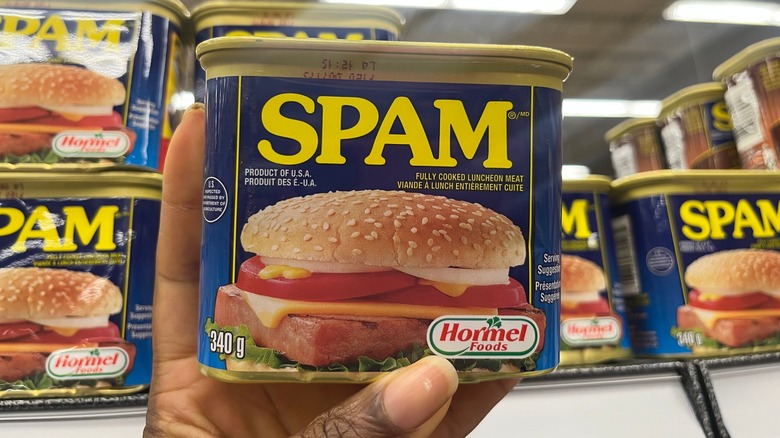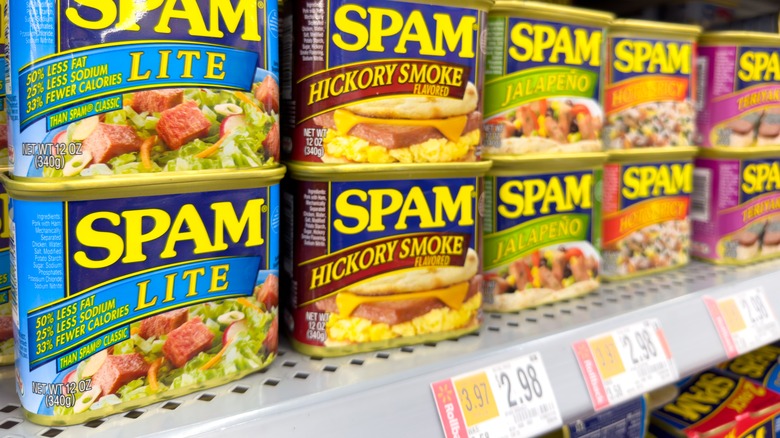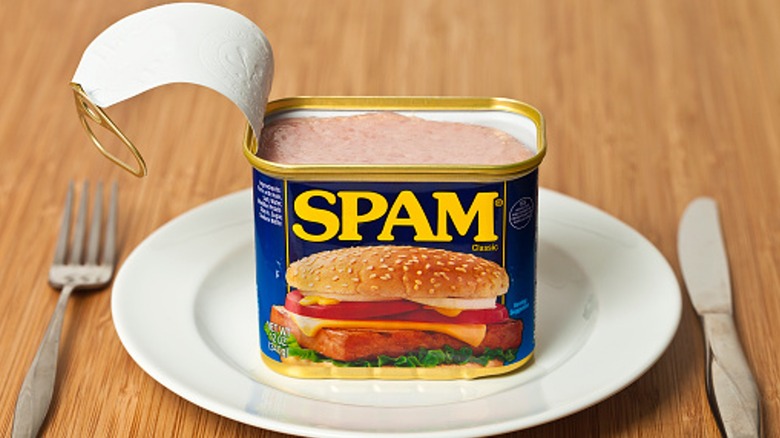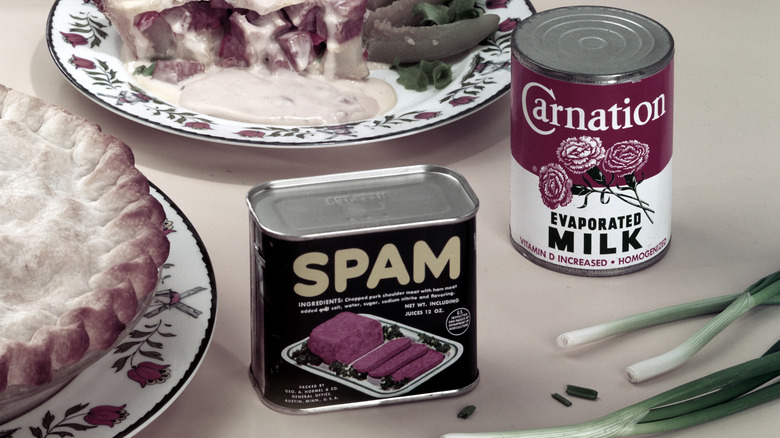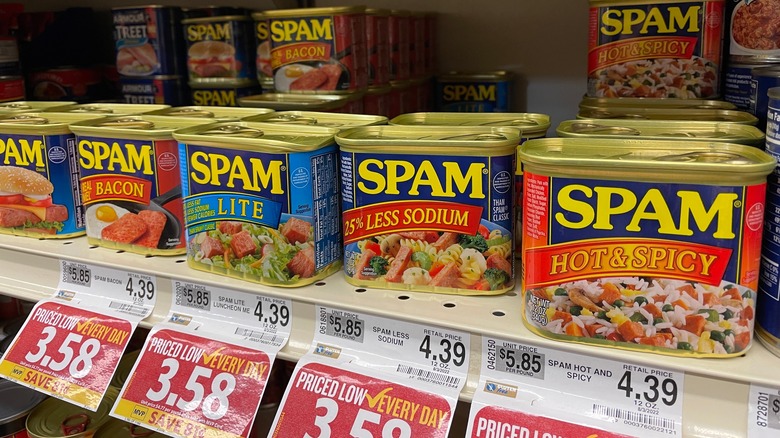The 9 Most Popular Myths About Spam
We may receive a commission on purchases made from links.
Spam. Whether you eat it out of the can, cook with it, use it as an ingredient to upgrade your macaroni and cheese, despise it, or have never ventured to try it, you probably think you know a lot about this canned ham made by Hormel Foods. But, what if we told you that much of what you think you know actually isn't true?
For canned meat, Spam has garnered a lot of attention over the years. It has been the topic of many conversations — and even television sketches. Many people view it as a food that was made to feed the troops during World War II, assume that it is only sold in the United States, or wonder why it is even still on the shelves since they believe it is no longer popular. However, much of what people understand to be facts about this long-lasting pantry supply aren't actually true. Continue reading to learn more about these and other popular Spam myths that simply aren't true.
1. Spam is only available in one flavor
Spam is Spam, right? There is only one flavor of this canned ham. Well, that's what many people think, but that's not the truth. In reality, there are several different flavors and variations of Spam, allowing it to be used for various recipes that match a range of tastes and preferences.
In addition to Classic Spam, you can also try Korean BBQ Flavored Spam, Maple Flavored Spam, Spam with added Hormel Bacon, Hot and Spicy Spam, Jalapeño Spam, Hickory Smoke Flavored Spam, Teriyaki Spam, or Spam with Tocino Seasoning. There are also lite and lower sodium versions of the classic recipe available for those with dietary restrictions. In addition to all of these options, Spam Classic and Spam Lite are available in single-serving pouches, making them a convenient addition to your lunchbox when packing for work or school. Now that you know all of these different varieties exist, you can work them into various recipes.
2. Spam was made because of WWII
One pervasive myth about Spam is that it was created due to the outbreak of World War II. While it is understandable why people think that, it isn't the truth. World War II didn't start until 1939, and Spam's official release was in 1937. However, while Spam wasn't technically made because of the war, it grew in popularity and became more recognized because of its important role during combat.
As a canned meat, Spam was ideal for serving to the troops. It would keep for a long time, so there was no risk of it spoiling. It was commonly consumed by Allied troops, including those fighting for The Soviet Union. Years later, Nikita Khrushchev, the leader of the Soviet Union during the war, wrote in his biography that Spam played an important role in saving the Soviet Army and helping them prevail in the war. Spam's popularity continued to grow during and after the war. By 1959, just over 20 years after it was first released, one billion cans of Spam had been sold around the world.
3. You can only buy Spam in America
"Spam is an American food" is another myth you may have always assumed was true. This isn't true now and wasn't true even several years ago. As we previously mentioned, even just a few years after Spam was released, it was being used to keep the troops of many Allied countries nourished during World War II. In 1941, the Lend-Lease Act was signed, granting the United States government permission to share (lend or lease) supplies with other countries during the war. Spam was one of these supplies that was included with aid sent to other countries, specifically the Soviet Union and Great Britain. Between its introduction to these other countries through the act and how the canned ham's popularity spread even in Axis countries after the war, it has never been solely an American food.
Today, Spam is an international brand. It is available in 50 countries across the globe, including a concentration in North America, Central America, Asia, and Australia. In fact, in many Asian countries, Spam is more than just a mundane item to buy at the store. It is a key component of many Asian dishes, such as kimchi fried rice and Spam musubi.
4. Spam has fallen in popularity
OK, so maybe Spam used to be really popular and played an important role in nourishing Allied troops. But, this canned ham has surely seen its heyday and is likely to be pulled from shelves due to lack of popularity. Right? Wrong. This, too, is another myth. Spam continues to be very popular among many consumers. It continues to be a staple in many Asian dishes, contributing to its popularity. Plus, Spam has endless applications in existing recipes, such as modifying a Jambon-Beurre sandwich.
As of 2022, the 85th anniversary of the canned meat, more than 9 billion units had been sold across the globe. And many of these sales were recent, with the company reporting seven years of record-breaking sales. The company website even boasts that 12.8 cans of Spam products are consumed every second. Now, that doesn't sound like a food product in danger of getting pulled from the shelves. Hormel even set up an entire museum dedicated to their popular canned ham. The Spam Museum, located in Austin, Minnesota, sees over 100,000 visitors annually
5. No one really knows what's in Spam
Another commonly believed myth is that Spam is made from a mystery meat. Contrary to popular belief, this canned food product has a relatively short ingredient list. There are only six ingredients: pork with ham, salt, water, potato starch, sugar, and sodium nitrate. Five of these six ingredients are self-explanatory, but you may not have heard of sodium nitrate. It is a preservative that is added to keep the meat fresh and extend its shelf life.
The production process for Spam is also rather basic. After grinding up the pork with ham — remember, ham is considered red meat — the salt, water, sugar, potato starch, and sodium nitrate are mixed into it. The resulting mix is then added to the cans, which are vacuum sealed. Everything actually cooks right inside the cans, instead of being cooked before being added, as you might guess. After a brief cooling period, the Spam is ready to sell.
6. Everyone knows what Spam stands for
Everyone has an idea of what Spam stands for. Most people don't even consider the possibility that their interpretation of the name could be wrong. Some believe the name stands for shoulder of pork and ham, while others assume it's an acronym for scientifically processed animals matter. There are other guesses as well, many of which are incorrect.
As far as we can tell, Spam stands for spiced ham. It is an example of a portmanteau — two existing words and their meanings combined to form a new word. In this case, the "sp" from the beginning of spiced and the "am" from the ending of ham are combined to create Spam. Ken Digneau is credited with naming the canned meat. He was the brother of one of the Hormel executives when the product was first released and participated in the naming contest the company was running for their new creation. His entry was selected, which is why the canned good carries the enigmatic moniker to this day.
7. A can of Spam never expires
Spam and other canned meats are regularly recommended for those stocking up for an emergency. Many believe that Spam never expires, so if you buy it today and leave it in the back of your pantry or with emergency supplies, it will still be good in 20, 30, or even 50 years. However, although Spam has a long shelf life, it does not last forever. Hormel Foods places a "best by" date on the bottom of every Spam product they sell.
Remember, expiration dates can have different meanings, and not all dates printed on food items are true expiration dates. A best-by date, such as that listed on the cans of Hormel Foods Spam, indicates the recommended date to consume the product for maximum flavor. The canned ham may still be good a while beyond this date. However, you don't want to push things too much. As a general rule, you probably shouldn't try to eat Spam that is more than 3 or 4 years old. If you want to extend the shelf life of your Spam, it is also important to store it in a cool and dark place.
8. Spam is the most expensive canned meat
Just as Wagyu is known for being a very expensive meat and Spam is a well-known brand, it is thought that the Hormel product is one of the more expensive canned meats on the market. And, while it is not overly expensive, the idea that it is the most expensive canned meat is a myth. A 12-ounce can of Spam retails for $3.98, which works out to 33 cents per ounce. While reasonable, a few other canned meats at Walmart alone are more expensive than this.
As one example, a 12-ounce can of Great Value Pulled Pork in BBQ Sauce retails for $4.12. The price per ounce for this is 34 cents, making it just a bit more expensive than Spam. Keystone All Natural Beef is even more expensive. A 14.5-ounce can of it sells for $5.87, which works out to be about 40 cents per ounce. However, Libby's Corned Beef is the most expensive of all of these canned meats available from Walmart. A 12-ounce can costs $5.67, making it 47 cents per ounce. This means that it is about 14 cents per ounce more expensive than Spam.
9. The term for spam junk mail is in no way tied to the canned food
Today, when most of us use the word "spam" we aren't referring to canned ham. Instead, we are talking about the near-constant inundation of junk mail, telemarketer calls, and emails that flood our mailboxes, voicemails, and inboxes. Most of us don't consider the possibility that this use of "spam" has any connection to the name of the canned ham sold by Hormel Foods. Believe it or not, spam, as it refers to junk mail, and Spam, the canned ham, are actually related, and you can thank Monty Python.
In 1970, one of the sketches on "Monty Python's Flying Circus" took place in a cafe where two people were trying to order breakfast. The waitress read off the menu items, nearly all of which contained Spam. One of the customers expressed frustration as she wanted something without Spam, while another customer tried to point out which dishes had less Spam. At many mentions of the word Spam, some Vikings, sitting at one of the tables in the restaurant, broke into songs about the canned ham, drowning out her order requests.
Her experience was similar those who remember the early inboxes of the '90s that were stuffed with unsolicited mail, through which people had to sift to find their "real" mail. Then, in 1994, the publication "Network World" described this as a "spam attack," and from there, the term caught fire.
